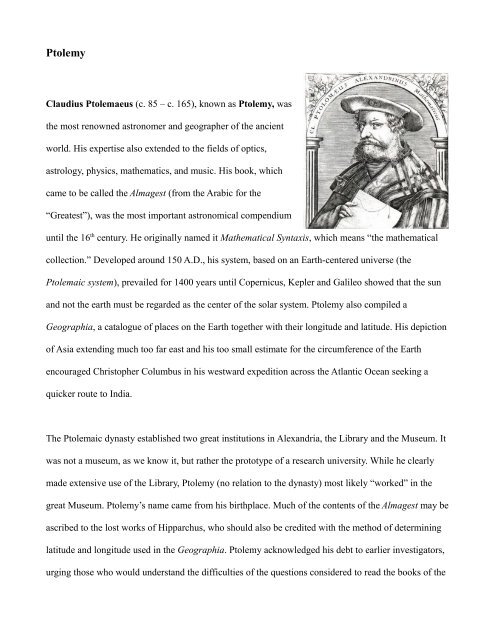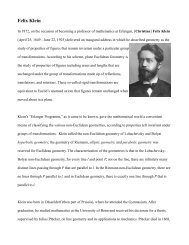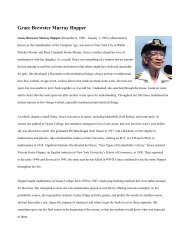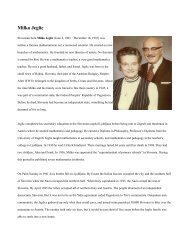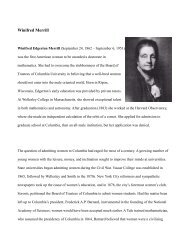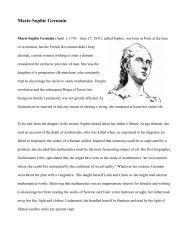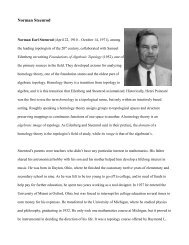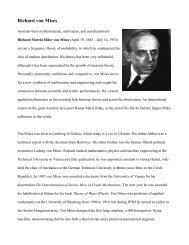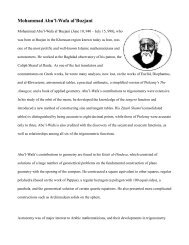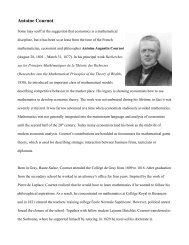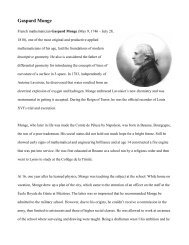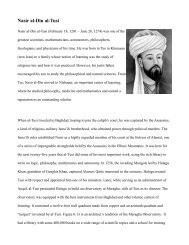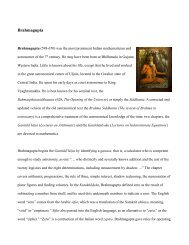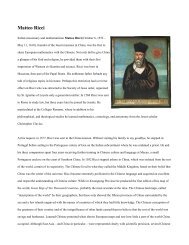Ptolemy
Ptolemy
Ptolemy
- No tags were found...
Create successful ePaper yourself
Turn your PDF publications into a flip-book with our unique Google optimized e-Paper software.
<strong>Ptolemy</strong>Claudius Ptolemaeus (c. 85 – c. 165), known as <strong>Ptolemy</strong>, wasthe most renowned astronomer and geographer of the ancientworld. His expertise also extended to the fields of optics,astrology, physics, mathematics, and music. His book, whichcame to be called the Almagest (from the Arabic for the“Greatest”), was the most important astronomical compendiumuntil the 16 th century. He originally named it Mathematical Syntaxis, which means “the mathematicalcollection.” Developed around 150 A.D., his system, based on an Earth-centered universe (thePtolemaic system), prevailed for 1400 years until Copernicus, Kepler and Galileo showed that the sunand not the earth must be regarded as the center of the solar system. <strong>Ptolemy</strong> also compiled aGeographia, a catalogue of places on the Earth together with their longitude and latitude. His depictionof Asia extending much too far east and his too small estimate for the circumference of the Earthencouraged Christopher Columbus in his westward expedition across the Atlantic Ocean seeking aquicker route to India.The Ptolemaic dynasty established two great institutions in Alexandria, the Library and the Museum. Itwas not a museum, as we know it, but rather the prototype of a research university. While he clearlymade extensive use of the Library, <strong>Ptolemy</strong> (no relation to the dynasty) most likely “worked” in thegreat Museum. <strong>Ptolemy</strong>’s name came from his birthplace. Much of the contents of the Almagest may beascribed to the lost works of Hipparchus, who should also be credited with the method of determininglatitude and longitude used in the Geographia. <strong>Ptolemy</strong> acknowledged his debt to earlier investigators,urging those who would understand the difficulties of the questions considered to read the books of the
ancients, especially those of Hipparchus, whom he praised as “a lover of labor and a lover of truth.”<strong>Ptolemy</strong> used geometric models to predict the positions of the sun, moon, and planets, usingcombinations of some 80 circular motions known as epicycles. He taught that the five then knownplanets and Sun orbited the Earth in the order Mercury, Venus, Sun, Mars, Jupiter, and Saturn [Figure11.6a]. Although based on naked-eye observations, his system predicted the positions of the planetsfairly accurately. The Almagest contained tables needed for astronomical calculations, as well as a starcatalogue of 1028 stars in 48 constellations, whose names are still used today.<strong>Ptolemy</strong> introduced very few new mathematical techniques, but modified existing ones to suit hisneeds. In his system a planet moves on perfect circles, but not at uniform speed. He introduced ageometric device that he called an equant point around which the planet moves at a steady angularspeed. Given any ellipse, we can draw its eccentric circle by constructing the circle that has the samecenter as the ellipse and has a radius equal to the semi-major axis of the ellipse [Figure 11.6b]. That is,the eccentric circle circumscribes the given ellipse. The equant point (Q) is located on the lineconnecting the earth (E) with the center of the planet’s eccentric circle (C), such that QC = CE [Figure11.6]. From the equant point there is the illusion that the motion of the orbiting planet is at a steadyspeed.
11.6<strong>Ptolemy</strong> did not intend to develop a new theory of cosmology. Instead, he did what he could to reestablishAristotle’s claims for a geocentric universe. <strong>Ptolemy</strong> argued that since all bodies fall to thecenter of the universe, the Earth must be fixed at the center; otherwise falling objects wouldn’t be seento drop toward the center of the Earth. He believed that the Earth is stationary; otherwise, a body
thrown vertically upward would not fall back to the same place, as in fact it does. This constituted hisproof of the Earth as the center of the universe. He introduced the notion of deferents, large orbits aboutthe Earth that the planets followed while circulating in their own epicycles located on the deferentorbit. <strong>Ptolemy</strong> wrote that: “the first order of business is to grasp the relationship of the earth taken as awhole to the heavens taken as a whole.” He reported that the heaven is spherical in shape and movesspherically. Likewise, when taken as a whole, the Earth is sensibly spherical in shape and is the middleof the heavens. The Earth has the ratio of a point relative to the size of the heavens and it has no motionfrom place to place. He added that there are two different primary motions in the heavens: the first isthe daily motion, which “carries everything from east to west”; the second is the motion of the sun,moon and five planets along the ecliptic from west to east. His configuration was surprisingly adequatemathematically, despite being based on an erroneous model of the universe.<strong>Ptolemy</strong> can’t be held accountable for the results of his theories being accorded almost divine authoritywhen they re-entered Christian Europe in the 12 th and 13 th century in Latin translations of Arabic works.They were so revered that to challenge their erroneous pronouncements about the universe and thegeocentric theory of the cosmos was to find oneself subject to censure, excommunication and worse.<strong>Ptolemy</strong>’s geocentric system represented the best science of his day, but St. Thomas Aquinas did such aremarkable job of incorporating it into Christian theology, that lesser thinkers concluded that Christiandoctrine required that <strong>Ptolemy</strong>’s models be taken as the definitive explanation of the workings of theuniverse. It required considerable daring to propose other explanations. Even with the invention of thetelescope, which made the errors of the Ptolemaic system apparent to those who would look through itto the heavens; it was defended vigorously as if it was gospel. Nevertheless it would be an injustice notto honor <strong>Ptolemy</strong> for his accomplishments. Although his scientific explanations of the universe havebeen superseded by others this doesn’t detract from his brilliance as a scholar and scientist.
<strong>Ptolemy</strong> is celebrated as a geographer as well as an astronomer. In Geographia, he attempted to mapthe known world by assigning coordinates to major places in terms of longitude and latitude. Hediscussed the known continents at that time, Africa, Asia and Europe, but the work did not extendbelow the equator. His 26 color regional maps and single world map were often inaccurate due to thevague reports from traveling merchants and Roman officials. <strong>Ptolemy</strong>’s estimates of the size of theknown world were roughly 4,580 miles from north to south and 8,250 miles from west to east. Whilehis map of Greece and the Aegean was rich in detail and elegantly executed, he underestimated the sizeof the oceans and overestimated the landmass from Spain to China. Despite their errors his maps werefar superior to those drawn in the Dark Ages of Europe. It was from <strong>Ptolemy</strong>’s rediscovered works thatRenaissance mapmakers learned their craft, without which the navigations of the fifteenth andsubsequent centuries could not have taken place.Quotation of the Day: “<strong>Ptolemy</strong> … fully realized that his theory [of planetary motion] was just aconvenient mathematical description which fit the observations and was not necessarily the true designof nature. For some planets he had a choice of alternate schemes and he chose the mathematicallysimpler one. <strong>Ptolemy</strong> says in Book XIII of his Almagest that in astronomy one ought to seek as simple amathematical model as possible. But <strong>Ptolemy</strong>’s mathematical model was received as the truth by theChristian world.” – Morris Kline


